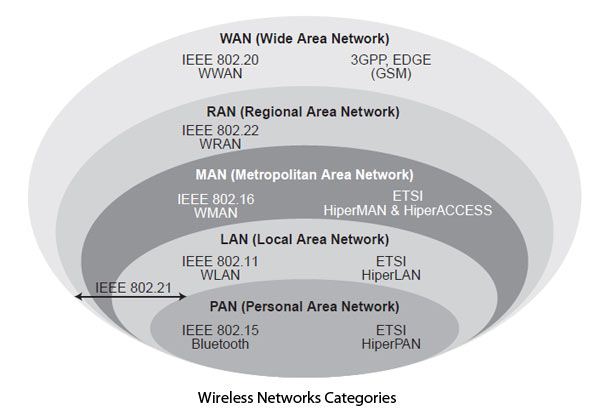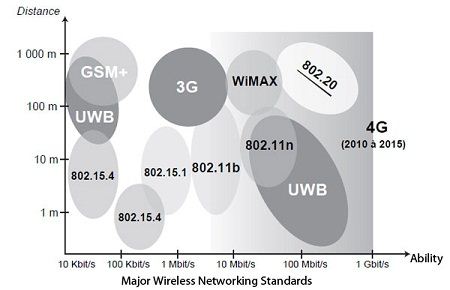Wireless networks are developing due to the flexibility of their interface, which allows a user to change positions while staying connected. Communications between terminals can be made directly or via base stations, called access points, or AP (Access Point). Communication between access points can be wireless or cable. The flow rates of these networks are tens of megabits per second.
Several product lines are currently marketed, but standardization could still change things. The working groups that are responsible for this standardization are from the US IEEE and ETSI on the Old Continent. Figure describes the different types of networks according to their extension and figure the existing standards.

The main standards are IEEE 802.15, for small personal networks than ten meters range, IEEE 802.11, or Wi-Fi for WLAN (Wireless Local Area Network), IEEE 802.16 WMAN networks for (Wireless Metropolitan Area Network) reaching over ten kilometers, IEEE 802.22, for WRAN (Wireless Regional Area Network), and IEEE 802.20, for WWAN (Wireless Wide Area Network) networks, which correspond to cell solutions to cover a country. For this category of networks, we selected the proposal IEEE 802.20, which can be considered a multimedia solutions at very competing broadband of the future fourth generation mobile networks.

In the IEEE 802.15 group, three subgroups standardize product lines in parallel:
• IEEE 802.15.1, the best known, supports the Bluetooth standard today widely marketed. Version 3.0 uses the radio interface described in IEEE 802.15.3, which provides Bluetooth to a new youth, with a rate of 480 Mbit/s.
• IEEE 802.15.3 standard defines the UWB (Ultra Wide Band), which uses a special technology, characterized by the emission at extremely low power, under the ambient noise, but virtually all of the radio spectrum (between 3.1 and 10.6 GHz). The flow rate is 480 Mbit / s over a range of 3 m and decreases to about 120 Mbit / s to ten meters.
• IEEE 802.15.4 handles the ZigBee standard, which aims to promote chip with a relatively low speed but at a very low cost. ZigBee standard is primarily for the passage of commands rather than data. However, a version released in 2007 proposes using UWB and thus still offers a high flow rate.
On the side of the IEEE 802.11 standard, whose products are named Wi-Fi (Wireless-Fidelity), there are now three proposals, the rates are 11 Mbit/s (IEEE 802.11b) and 54 Mbit / s (IEEE 802.11a and g). A fourth proposal, from the work of the IEEE 802.11n group, allows to significantly increasing the throughput, with hundreds of Mbps actual throughput at best. The frequencies used are placed in the 2.4 to 2.483 5 MHz for extensions b and g and 5.15 to 5.35 MHz in the band for 802.11a.
Wireless networks IEEE 802.16 are intended to replace ADSL modems, which are found on fixed telephone networks, to give the end user data rates of the same order of magnitude as ADSL, up to several megabits per second. These networks comprise what is called the wireless local loop. Several standards are proposed according to the frequency used. A consortium set up to develop applications of this standard as WiMAX name. Two versions are offered, one fixed, the aim is clearly to replace ADSL in rural areas, the other mobile, allowing for an ADSL modem in his pocket and always connected.
Regional networks are studied by IEEE 802.22. The cell radius up to 50 kilometers for frequency ranges below 1 GHz. The potential distance of the terminal significant, the flow amount is limited. However, on the down band, 4 Mbit / s are available. The basic application is interactive television or interactive video games.
Regarding the WAN (Wide Area Network), but rather the interconnection of previous networks supporting them. For this it was necessary to define a standard for connecting, which was brought by the specifications of IEEE 802.21 group. Can also be classified in this category IEEE 802.20, which is consistent cells and allows broadband access.
 Dinesh Thakur holds an B.C.A, MCDBA, MCSD certifications. Dinesh authors the hugely popular
Dinesh Thakur holds an B.C.A, MCDBA, MCSD certifications. Dinesh authors the hugely popular